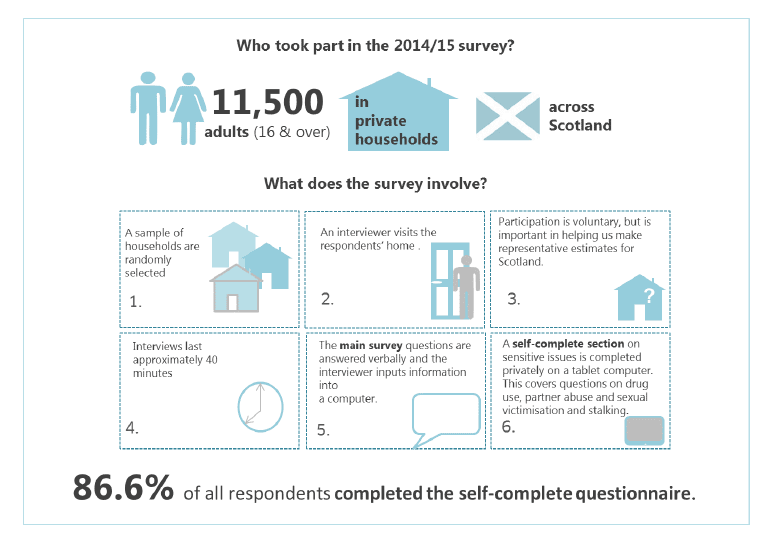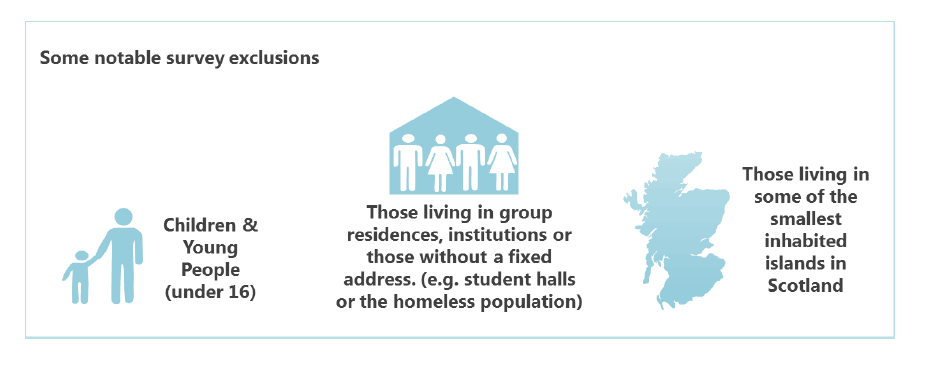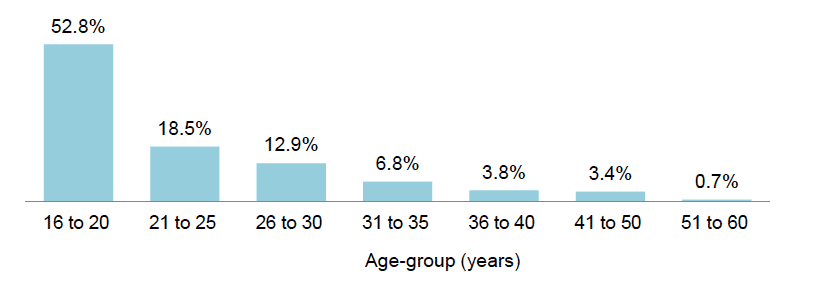Scottish Crime and Justice Survey 2014/15: Sexual Victimisation & Stalking
Findings from the SCJS 2014/15 on Sexual Victimisation and Stalking.
1. The Scottish Crime and Justice Survey
1.1 Introduction
The Scottish Crime and Justice Survey ( SCJS) is a large-scale social survey which asks people about their experiences and perceptions of crime. The 2014/15 survey is based on around 11,500 face-to-face interviews with adults (aged 16 or over) living in private households in Scotland.
The main aims of the SCJS are to:
- Enable the Scottish population to tell us about their experiences of, and attitudes to, a range of issues related to crime, policing and the justice system; including crime not reported to the police;
- Provide a valid and reliable measure of adults' experience of crime, including services provided to victims of crime;
- Examine trends, over time, in the number and nature of crimes in Scotland, providing a complementary measure of crime compared with police recorded crime statistics;
- Examine the varying risk and characteristics of crime for different groups of adults in the population.
The findings from the survey are used by policy makers across the public sector in Scotland to help understand the nature of crime, target resources and monitor the impact of initiatives to target crime. The results of this survey provide evidence to inform national outcomes and justice outcomes.
This report presents findings from the self-completion module on sexual victimisation and stalking. The report provides data and analysis on the extent of sexual victimisation and stalking in Scotland amongst adults aged sixteen or over.
1.2 Survey Design

The design of the 2014/15 SCJS remains broadly similar to the design of the SCJS from 2008/09 to 2012/13:
- Survey frequency : Following the completion of the SCJS 2010/11, the SCJS moved to a biennial design. Therefore, no survey ran in 2011/12 or 2013/14 [1] .
- Sample: the sample is designed to be representative of all private residential households across Scotland (with the exception of some of the smaller islands). A systematic random selection of private residential addresses across Scotland was produced from the Royal Mail Postcode Address File ( PAF) and allocated in batches to interviewers. Interviewers called at each address and then selected one adult (aged 16 or over) at random from the household members for interview.
- Questionnaire: the questionnaire consists of a modular design completed by the interviewer using Computer-Assisted Personal Interviewing ( CAPI) and a self-completion section covering sensitive crimes using Computer-Assisted Self Interviewing ( CASI). The most recent questionnaire is available on the SCJS webpage. Questions on sexual victimisation and stalking were included in the self-completion section of the questionnaire, which was undertaken at the end of the main SCJS interview.
- Interviews and response rate: 11,472 face-to-face interviews were conducted in respondents' homes by professional interviewers, with a response rate of 63.8%. Interviews lasted an average of 40 minutes, though there was variation in interview length, depending on the respondent's reported experience. Additional to the main questionnaire, all survey respondents were asked to fill out a self-completion section (on a tablet computer) on more confidential and sensitive issues, including drug taking, partner abuse, sexual victimisation and stalking.
In 2014/15, 9,986 respondents completed the self-completion module, that is 86.6% of all respondents. The most common reason for refusing to complete the self-complete questionnaire was 'running out of time' (mentioned by almost half of respondents who refused); more details are provided in the Technical Report (section 6.6.2). An equal proportion of men and women answered the self-completion questionnaire. However, the proportion of those who completed the self-completion section decreased with age. Further information on response rates can be found in the Technical Report (section 3.4).
- Fieldwork: interviews were conducted on a rolling basis between 1 st April 2014 and 31 st May 2015, with roughly an equal number of interviews conducted in each month between April 2014 and March 2015. Challenges in fieldwork delivery were experienced in 2014/15 and as a result, the fieldwork period was extended by two months to increase the achieved sample size.
- Weighting: the results obtained were weighted to correct for the unequal probability of selection for interview caused by the sample design and for differences in the level of response among groups of individuals. Given that not all respondents chose to answer the self-completion questionnaire, these data are weighted separately to the main questionnaire (using identical weighting procedures). Further details of the weighting used are provided in the Technical Report (section 4).
1.3 Survey Coverage
The SCJS does not aim to provide an absolute estimate for all crime and has some notable exclusions. The SCJS is a survey of adults living in private residential households and, therefore, does not provide information on crimes against adults living in other circumstances (for example those living in institutions or communal residences, such as prisons or hospitals, military bases and student accommodation). Those living in some of the smallest inhabited islands in Scotland are excluded for practical reasons (see Annex 1 of the accompanying Technical Report for details).

1.4 Key definitions and measures
Respondents are asked about their experiences of sexual victimisation and stalking/harassment within the last 12 months and additionally, their experiences of sexual victimisation since the age of 16.
For ease of reference, the report categorises sexual victimisation into two groups: serious sexual assault and less serious sexual offences. These terms do not relate to the seriousness of the impact on the individual.
The following experiences are defined as forms of stalking and harassment:
- Being sent unwanted letters or cards on a number of occasions that were either obscene or threatening
- Being sent unwanted emails or text messages on a number of occasions that were either obscene or threatening
- Receiving a number of unwanted approaches via social networking sites that were either obscene or threatening
- Receiving a number of obscene, threatening, nuisance or silent telephone calls
- Having someone waiting outside their home or workplace on more than one occasion
- Being followed around and watched on more than one occasion
The following experiences are defined as serious sexual assault:
- Forcing someone to have sexual intercourse.
- Attempting to force someone to have sexual intercourse.
- Forcing someone to take part in other sexual activity.
- Attempting to force someone to take part in other sexual activity.
And the following experiences are defined as less serious sexual offences:
- Indecent exposure ( i.e. flashing).
- Sexual threats (for example, someone demanding sex when you did not want it, being followed or cornered in a sexually threatening way)
- Being touched sexually when it was not wanted (for example, groping or unwanted kissing).
A full transcript of the survey questionnaire is available on the SCJS website.
1.4.1 Sexual victimisation, stalking and partner abuse
There may be some overlap between the incidents of sexual victimisation and stalking detailed in this report, and incidents of partner abuse, which are analysed separately in the Partner Abuse report. To explain, the self-completion module asks respondents about their experiences of sexual victimisation/stalking and partner abuse separately. Given that sexual/victimisation and partner abuse can involve similar behaviours and experiences, it is possible that some of the incidents detailed in this report are duplicated in the Partner Abuse report. It is also possible that some incidents of sexual victimisation/stalking detailed in this report constituted partner abuse, but were not viewed or reported as such by respondents.
1.4.2 Comparisons with crimes and offences
Incidents of stalking, harassment and sexual victimisation recorded in the self-completion module are not directly comparable with police recorded crimes and offences. This is because a limited number of follow-up questions are asked about these incidents (in order to avoid causing possible distress to respondents), which prevents the accurate classification of incidents. For further details on comparable crimes in the SCJS 2014/15, see the Offence Coding Manual.
1.5 Conventions used in figures and tables
Each figure or table has a title, the data source (survey year), a base description (the number of people who answered the question), the unweighted base (the number of respondents in each category), and the SPSS variables. For example:
Figure 3.2 Age at time of first (or only) incident of serious sexual assault, by age-group (%)

Base: All respondents who experienced serious sexual assault since age 16 (332)
Variable names: SA_ANY_EV, QDAGE
1.5.1 Percentages
Table row or column percentages may not sum to 100 due to rounding.
Percentages presented in tables and figures where they refer to the percentage of respondents, households or crimes that have the attribute being discussed may not sum to 100 per cent. Respondents have the option to refuse answering any question they did not wish to answer and the majority of questions have a 'don't know' option. Percentages for these response categories are generally not shown in tables and figures.
A percentage may be quoted in the report text for a single category that is identifiable in the figures/tables only by summing two or more component percentages. In order to avoid rounding errors, the percentage has been recalculated for the single combined category and therefore may differ by one or two percentage points from the sum of the percentages derived from the figures/tables.
Also, percentages quoted in the report may represent variables that allow respondents to choose multiple responses. These percentages will not sum to 100 per cent with the other percentages presented. They represent the percentage of the variable population that select a certain response category.
1.5.2 Table abbreviations
' - ' indicates that no respondents gave an answer in the category.
'n/a' indicates that the SCJS question was not applicable or not asked in that particular year.
' * ' indicates that changes are statistically significant at the 95% level.
1.5.3 Decimal Points
Results from the self-complete section of the survey are generally reported to one decimal place. The self-complete questionnaire collects information on a range of often rare events; therefore, many of the figures reported are small (often under 1%). There is a range of uncertainty around all survey estimates. As outlined below (in sections 1.4.4 and 1.4.5), statistical testing is conducted to assess whether changes and differences between survey results are statistically significant. Only changes and differences which have been tested and assessed as representing statistically significant are highlighted as such in this report.
1.6 Survey error and statistical significance
1.6.1 Survey error
There may be errors in the recall of participants as to when certain incidents took place, resulting in some crimes being wrongly included in, or excluded from, the reference period. A number of steps in the design of the questionnaire are taken to ensure, as far as possible, that this does not happen (for example repeating key date questions in more detail).
The SCJS gathers information from a sample rather than from the whole population and, although the sample is designed carefully, survey results are always estimates, not precise figures. Estimates can differ from the figures that would have been obtained if the whole population had been interviewed.
It is, however, possible to calculate a range of values around an estimate, known as the confidence interval (also referred to as margin of error) of the estimate. At the 95 per cent confidence level, over many repeats of a survey under the same conditions, one would expect that the confidence interval would contain the true population value 95 times out of 100. This can be thought of as a one in 20 chance that the true population value will fall outside the 95 per cent confidence interval calculated for the survey estimate.
Because of this variation, changes in estimates between survey years or between population subgroups may occur by chance. In other words, the change may simply be due to which adults were randomly selected for interview.
1.6.2 Statistical Significance
We are able to measure whether changes in data across years, or differences between categories, are likely to be the case using standard statistical tests. From these, we can conclude whether differences are likely to be due to chance, or represent a real difference in the underlying population.
Many of the tests for statistical significance in this report, particularly when examining results by different demographic sub-groups, were carried out using the Pearson chi-square test in SPSS [2] , based on individual scaled data. All significant changes highlighted in this report were found to be statistically significant at the p ≤ 0.05 level.
The assessments of statistical change over time which are presented in this report use estimated confidence intervals around survey results to examine whether the change is statistically significant. The estimated confidence intervals used in these tests use generic SCJS design factors of 1.2 for 2014-15 results. More detail on the derivation of these confidence intervals and design factors is available in Chapter 11 of the SCJS Technical Report
Only increases or decreases that are statistically significant at the 95 per cent level are described as changes within this report, and in the tables and figures these are identified by asterisks. Where no statistically significant change has been found between two estimates, this has been described as showing 'no change'. The presentation of uncertainty and change in this report reflect best practice guidance produced by the Government Statistical Service ( GSS).
1.7 Accessing Survey Data
Information on how to access SCJS data is available on the Data Access section of our webpage.
1.8 Report Structure
This report consists of three substantive chapters.
Chapter 2 examines stalking and harassment and provides data on: the overall risk and varying risk of stalking and harassment, victim-offender relationships and reporting to the police (including reasons for non-reporting). Chapter 2 also provides a short overview of cyber-stalking, which refers to the use of stalking and harassment via electronic communication such as texts and emails.
Chapter 3 examines serious sexual assault and provides data on the overall risk and varying risk of experiencing serious sexual assault, victim-offender relationships, the physical impact of serious sexual assault and reporting to the police.
Chapter 4 examines less serious sexual offences and chapter provides data on the overall and varying risk of experiencing less serious sexual offences, and victim-offender relationships.
Where appropriate, additional contextual information from other sources, including academic literature and data from the Scottish Social Attitudes Survey, 2014 is provided in text boxes. The report also draws on police recorded crime to provide further context.
The Annexes provide summary results and further background information.
Annex 1. Data Tables: Sexual Victimisation and stalking provides additional data tables
Error! Reference source not found. Error! Reference source not found.describes the SCJS data strengths and limitations
Contact
There is a problem
Thanks for your feedback